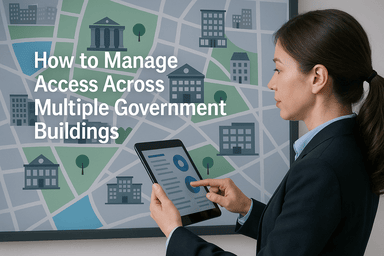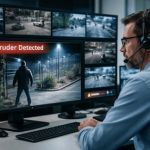
As municipalities grow and diversify their operations, one of the most overlooked security challenges is managing access control across multiple government-owned buildings. From city halls and fire stations to public works, libraries, and recreation centers, ensuring the right people have the right access at the right time is critical to protecting staff, assets, and the public.
In this guide, we’ll explore how to streamline and secure access management across a distributed portfolio of municipal facilities using modern tools and best practices tailored for the public sector.
k
k
The Complexity of Multi-Site Government Access Control
Managing access in a single building is already complex. But for cities and counties operating dozens of properties, challenges scale quickly:
-
Disparate systems: Each building may use a different access platform—cards at the courthouse, keys at the park office, and nothing at the community center.
-
Inconsistent policies: No standard rules for credential expiration, visitor check-in, or emergency lockdown procedures.
-
Limited oversight: City managers lack real-time insight into who has access to which facilities—and when.
Without a centralized strategy, municipalities risk security gaps, compliance issues, and operational inefficiencies.
k
k
Step 1: Move to a Unified Access Control Platform
The foundation of effective multi-building access control is a single, centralized system that spans all city properties.
What to look for:
-
Cloud-based access management for real-time control from any device
-
Multi-site credentialing that allows staff to use a single badge or mobile ID across all authorized locations
-
Role-based access levels to tailor entry privileges by department or position
SSP helps local governments standardize access control across facilities using scalable, secure platforms that meet CJIS, FIPS, and NDAA Section 889 requirements.
k
k
Step 2: Standardize Credential Issuance and Expiration
When each department manages credentials differently, there’s no accountability. A unified system enables:
-
Automated provisioning for new hires across multiple buildings
-
Scheduled expiration for temporary staff, contractors, or seasonal workers
-
Deactivation upon termination—instantly and across all sites
For added efficiency, integrate with your HR or identity management system so access levels automatically reflect employment status.
k
k
Step 3: Implement Real-Time Activity Monitoring and Reporting
Central oversight is only possible when you can see and audit access activity citywide.
Modern systems provide:
-
Live dashboards showing entry attempts, door status, and alerts across all buildings
-
Custom reporting by user, location, or date range
-
Anomaly detection for failed access attempts or unusual after-hours entry
SSP’s platforms allow municipal security teams to monitor multi-site operations from a single screen, saving time and improving incident response.
k
k
Step 4: Coordinate Emergency Lockdown and Remote Management
In the event of a public threat or natural disaster, cities need the ability to lock down all facilities instantly, regardless of location.
Key features to look for:
-
Remote door lockdown/unlock capabilities
-
Mass notification integrations for alerting staff and the public
-
First responder access tools for controlled entry during crises
These features are essential for protecting lives and property when seconds matter.
k
k
Step 5: Train Staff and Standardize Procedures
Even the most advanced system can fail if staff aren’t properly trained.
To ensure consistency across departments:
-
Create a citywide access control policy that outlines credential issuance, revocation, and visitor handling
-
Train all facility managers on system use and emergency protocols
-
Conduct periodic audits to validate compliance and correct gaps
SSP provides onboarding and support services to help municipalities align their security practices across all locations.
k
k
Bonus: Add Visitor and Contractor Management
Government buildings welcome a wide variety of non-employee visitors—from vendors and maintenance crews to community members attending events. Your system should support:
-
Pre-registration and visitor passes
-
Time-limited credentials
-
Photo ID badging and check-in kiosks
By applying the same access standards to all entrants, cities can enhance security without sacrificing accessibility.
k
k
Build a Smarter, Safer City with Centralized Access Control
Managing access across multiple government buildings doesn’t have to be chaotic. With the right technology and strategy, cities can:
✅ Protect critical infrastructure
✅ Simplify operations for staff
✅ Enhance emergency readiness
✅ Maintain compliance with evolving standards
🔐 Ready to Unify Access Across Your City?
See how SSP helps government agencies protect their people and infrastructure.


